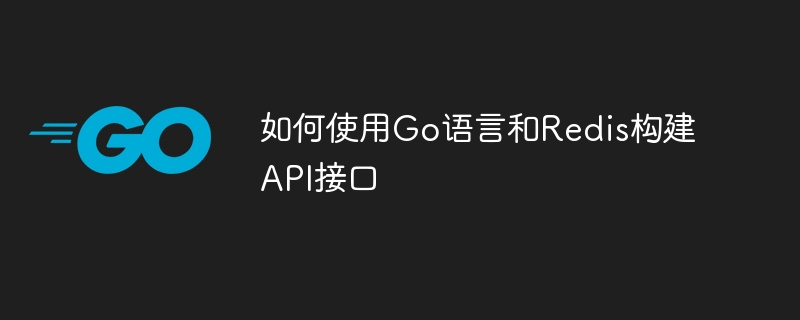

How to use Go language and Redis to build API interface
Overview:
Go language (Golang) is a concise, efficient, and powerful programming language, and Redis is an open source in-memory database that provides rich data structures and powerful query capabilities. This article will introduce how to use Go language and Redis to build API interfaces, and provide specific code examples.
Step 1: Install and configure the Go language environment
First, you need to install the Go language on your computer and set the relevant environment variables. After completing this step, we can use Go language for development.
Step 2: Install and configure Redis
Before you begin, you need to install Redis on your computer and make sure the Redis service is running. Then, we can interact with Redis through the Redis client library of the Go language.
Step 3: Create Go project and API interface
In Go language, you can use the "go mod" command to manage project dependencies. First, we need to create a new Go project and create an API interface in the project.
The sample code is as follows:
package main
import (
"github.com/gin-gonic/gin"
"github.com/go-redis/redis"
)
var client *redis.Client
func main() {
// 连接到Redis
client = redis.NewClient(&redis.Options{
Addr: "localhost:6379",
})
// 初始化路由器
router := gin.Default()
// 定义API接口
router.GET("/api/user/:id", getUser)
router.POST("/api/user", createUser)
router.PUT("/api/user/:id", updateUser)
router.DELETE("/api/user/:id", deleteUser)
// 启动服务
router.Run(":8080")
}
func getUser(c *gin.Context) {
// 从URL参数中获取用户ID
id := c.Param("id")
// 查询Redis中是否存在该用户信息
result, err := client.Get("user:" + id).Result()
if err == redis.Nil {
// Redis中没有该用户信息,返回404
c.JSON(404, gin.H{"error": "User not found"})
return
}
// 返回用户信息
c.JSON(200, gin.H{"user": result})
}
func createUser(c *gin.Context) {
// 从请求体中获取用户信息
user := c.PostForm("user")
// 将用户信息存储到Redis
err := client.Set("user:"+user.ID, user, 0).Err()
if err != nil {
// 存储失败,返回500
c.JSON(500, gin.H{"error": "Failed to create user"})
return
}
// 返回用户创建成功的信息
c.JSON(200, gin.H{"message": "User created successfully"})
}
func updateUser(c *gin.Context) {
// 从URL参数中获取用户ID
id := c.Param("id")
// 从请求体中获取用户信息
user := c.PostForm("user")
// 更新Redis中的用户信息
err := client.Set("user:"+id, user, 0).Err()
if err != nil {
// 更新失败,返回500
c.JSON(500, gin.H{"error": "Failed to update user"})
return
}
// 返回用户更新成功的信息
c.JSON(200, gin.H{"message": "User updated successfully"})
}
func deleteUser(c *gin.Context) {
// 从URL参数中获取用户ID
id := c.Param("id")
// 删除Redis中的用户信息
err := client.Del("user:" + id).Err()
if err != nil {
// 删除失败,返回500
c.JSON(500, gin.H{"error": "Failed to delete user"})
return
}
// 返回用户删除成功的信息
c.JSON(200, gin.H{"message": "User deleted successfully"})
}Step 4: Test the API interface
After completing the code writing, you can use curl or other tools to test whether the API interface is working properly. For example:
curl localhost:8080/api/user/1
curl -X POST -d " user={"ID": 1, "Name": "John"}" localhost:8080/api/user
curl -X PUT -d "user={ "ID": 1, "Name": "John Doe"}" localhost:8080/api/user/1
curl -X DELETE localhost:8080/api/ user/1
Summary: This article introduces how to use Go language and Redis to build an API interface. In this way, we can efficiently handle API requests and use Redis to store and query data. If you have a deeper understanding of the Go language and Redis, you can further expand and optimize this API interface to meet more needs.
The above is the detailed content of How to build an API interface using Go language and Redis. For more information, please follow other related articles on the PHP Chinese website!
 Usage of Type keyword in Go
Usage of Type keyword in Go
 How to implement linked list in go
How to implement linked list in go
 What are the Go language programming software?
What are the Go language programming software?
 How to learn go language from 0 basics
How to learn go language from 0 basics
 Commonly used database software
Commonly used database software
 What are the in-memory databases?
What are the in-memory databases?
 How to write api interface
How to write api interface
 What are the methods to implement operator overloading in Go language?
What are the methods to implement operator overloading in Go language?




